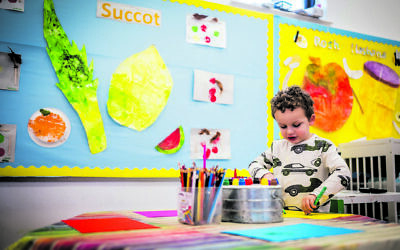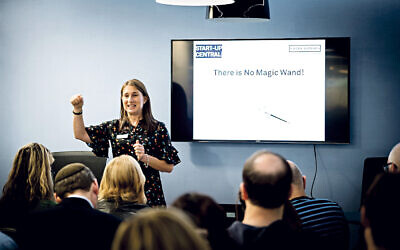Artist Yossi Rosenstein paints hope for Chanukah
Jenni Frazer talks to the Israeli creator of Life magazine's cover
He is one of Israel’s most famous artists, his paintings snapped up by collectors and selling for thousands of dollars. Yet, to hear Yossi Rosenstein tell it, his life in art very nearly didn’t happen, and he might have stayed within his strictly-Orthodox community in Jerusalem.

Rosenstein, who was born in 1950 and today lives in Bnei Brak, is a ninth-generation Israeli, descended from a prominent Slonimer Chasidic family. He was talented at drawing in his youth, he says, but acknowledges that art did not figure much in his religious world.
“Fifty-five years ago you could look at art only in a museum, in books and sometimes in a few galleries. There was no internet, nothing. But because in these places there would often be images of naked women – not nice for religious people to see – automatically all these things were outside my world.”
Get The Jewish News Daily Edition by email and never miss our top stories Free Sign Up
Things changed, however, when Rosenstein was 17, visiting his aunt in Montreal. It was 1967 and Expo 67, a world fair, was taking place there and the teenage Rosenstein had to see what was on view.
“There were artists showing their work from all over the world”, he says. “[It was] the first time I saw real art in full size, close to me. And it was amazing.” All these years later, you can still hear the thrill in his voice as he recalls this first encounter. “First, I was astonished at how people could create this work. And then I wanted to know why we, religious people, could not have this, too”.
Rosenstein regarded art then and now as “a gift from God – and we have to use it”. So excited was Rosenstein that he came back to his aunt from the Expo 67 and said he wanted to buy “colours, canvases, brushes – I wanted to make a picture”.

In his ignorance, he began to paint on the wrong side of the canvas, but he was so enthusiastic he started again, this time from inside the frame.
He had been making money in parallel with his yeshiva studies by playing drums, then guitar and organ, at weddings and simchas within his community. “But I stopped when I got married” – mainly because the weddings took place at night and he did not want to leave his new wife at home.
Rosenstein’s new-found enthusiasm for making art did not initially find favour in the strictly-Orthodox community. He explains: “We learn that beauty has to be found inside, not outside. If you are using outside, it means that you are not thinking like a Jew. We say, ‘Don’t look at a bottle from the outside, only look [at its contents] inside.’
“With art, everything is not real. This is why we have not had paintings in our community. But we also learn that if you can do it [something creative] it’s also a mitzvah to do it. We have to use everything that God gave us.”

But it was explained to him that it was possible to make art that was symbolic, which immediately struck a chord. Symbolism, for Rosenstein, meant the Torah – outwardly just a series of black marks on parchment but, if you had the key, there was a whole world waiting to unlock its secrets.
“I told myself, ‘I’m going to do the same with my art – and I will use the language that’s good for all over the world.’”

Encouraged by rabbis in Israel and the late Lubavitcher Rebbe, Rosenstein began to explore the joy of religious Judaism in his paintings, at first through oils and latterly through acrylic. He also set up schools, teaching many young Orthodox women who launched successful careers of their own.
But he was pretty sure he couldn’t make a living from art. Instead, he qualified as a rabbi and then went into the diamond trade, working in London’s Hatton Garden. “I said, I’ll take three years at this and then I will go back to painting. If that doesn’t work, I will return to the diamonds.” He pauses and you can hear the grin in his voice. “I never went back to the diamonds.”
Rosenstein had his first solo show in Tel Aviv in 1973. After three more solo shows in Israel, which attracted admirers from home and abroad, he was invited to show his work at the prestigious Manhattan art gallery Aberbach Fine Art. Since then, he has become an international success and, despite the fact that all his paintings show an aspect of Jewish life, from festivals to life cycle events, buyers of his work include many non-Jews.

The two paintings shown here, Hanukkah 1 and Menorah 1, depict some of Rosenstein’s very different styles – he also does detailed representational pictures of important buildings in Jewish life, such as the Western Wall or Rachel’s Tomb.
In Hanukkah 1, blurred figures are stretching out towards a golden chanukiah, glowing as if lit from within. Rosenstein says that candles, usually lit on the festivals, “are like mother love – they give of themselves without asking for anything in return”, adding: “The miracle of Hanukkah is not just the miracle of the oil burning for eight days, but that our people come together and unite.” This, he says, is an important message today.
And Menorah 1, with its sharp, bright blues and hot reds, has another meaning: “The menorah is the symbol of the Jewish people,” he says. “The red is for the blood we gave in order to stay Jewish. This is not just a menorah – it is us.”

All paintings © by Yossi Rosenstein
yossirosenstein.com /
@yossirosensteinartist

Thank you for helping to make Jewish News the leading source of news and opinion for the UK Jewish community. Today we're asking for your invaluable help to continue putting our community first in everything we do.
For as little as £5 a month you can help sustain the vital work we do in celebrating and standing up for Jewish life in Britain.
Jewish News holds our community together and keeps us connected. Like a synagogue, it’s where people turn to feel part of something bigger. It also proudly shows the rest of Britain the vibrancy and rich culture of modern Jewish life.
You can make a quick and easy one-off or monthly contribution of £5, £10, £20 or any other sum you’re comfortable with.
100% of your donation will help us continue celebrating our community, in all its dynamic diversity...
Engaging
Being a community platform means so much more than producing a newspaper and website. One of our proudest roles is media partnering with our invaluable charities to amplify the outstanding work they do to help us all.
Celebrating
There’s no shortage of oys in the world but Jewish News takes every opportunity to celebrate the joys too, through projects like Night of Heroes, 40 Under 40 and other compelling countdowns that make the community kvell with pride.
Pioneering
In the first collaboration between media outlets from different faiths, Jewish News worked with British Muslim TV and Church Times to produce a list of young activists leading the way on interfaith understanding.
Campaigning
Royal Mail issued a stamp honouring Holocaust hero Sir Nicholas Winton after a Jewish News campaign attracted more than 100,000 backers. Jewish Newsalso produces special editions of the paper highlighting pressing issues including mental health and Holocaust remembrance.
Easy access
In an age when news is readily accessible, Jewish News provides high-quality content free online and offline, removing any financial barriers to connecting people.
Voice of our community to wider society
The Jewish News team regularly appears on TV, radio and on the pages of the national press to comment on stories about the Jewish community. Easy access to the paper on the streets of London also means Jewish News provides an invaluable window into the community for the country at large.
We hope you agree all this is worth preserving.
-
By Brigit Grant
-
By Laurent Vaughan - Senior Associate (Bishop & Sewell Solicitors)
-
By Laurent Vaughan - Senior Associate (Bishop & Sewell Solicitors)
-
By Laurent Vaughan - Senior Associate (Bishop & Sewell Solicitors)
-
By Laurent Vaughan - Senior Associate (Bishop & Sewell Solicitors)






















